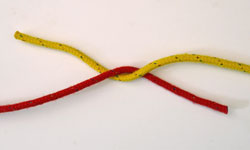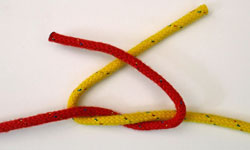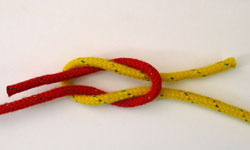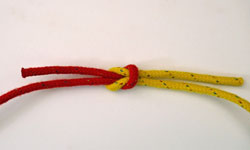- Home
- Essential Knots
- Reef Knot Sailing
Mastering the Reef Knot: Tying it Correctly for Sailing
In a Nutshell...
The reef knot, or square knot, is a simple and versatile binding knot. When tied correctly, it's used to securely join two lines of equal diameter, particularly for reefing a sail or bundling lines. It is not to be used as a bend for joining two active lines under load, as it can slip dangerously. The key to a proper reef knot is ensuring the two bitter ends lie on the same side of the standing parts after the second overhand knot is tied. A common mistake is tying a granny knot, which is prone to failure and occurs when the second overhand knot is tied in the opposite direction.
Table of Contents
As sailors, we're taught a handful of essential knots early on, and the reef knot is undoubtedly one of them. While seemingly simple, it's a knot that's often tied incorrectly, with potentially serious consequences.
This article will guide you through the correct method for tying a reef knot, explain its proper applications on board, and, perhaps most importantly, teach you how to spot a common and dangerous mistake.
What is a Reef Knot & Why is it Called a Square Knot?
The reef knot is a binding knot used to join two ropes of equal diameter. It is also known as a square knot because when tied correctly, the two loops form a symmetrical, square-like shape. This symmetry is your visual cue that the knot is sound. The name 'reef knot' comes from its traditional use for reefing a sail—the act of shortening a sail's area in strong winds. Sailors use reef points (short ropes or cringles) to secure the bunched-up sail to the boom, and the reef knot is the perfect knot for the job because it's secure but relatively easy to untie, even after being under tension.
Reef Knot vs. Granny Knot: A Dangerous Mistake
Tying the Perfect Reef Knot
This is where a little bit of sailing know-how can make a world of difference. The granny knot is a common error and is fundamentally a reef knot tied incorrectly. While it may look similar, it's asymmetrical and unstable, making it highly susceptible to slipping and coming undone, especially when wet or under load.
How to Spot the Difference:
Reef Knot: The bitter ends (the working ends of the line) will exit the knot on the same side as their corresponding standing parts (the parts of the line not being worked).
Granny Knot: The bitter ends and standing parts are on opposite sides, creating a lopsided, unstable shape.
An easy way to remember the correct method is: "Right over left, left over right."
Tying the Perfect Reef Knot
Here's the step-by-step process for tying a correct reef knot:

Stage 1
Remember the mnemonic?
Left over Right and Under;

Stage 2
Right over Left...

Stage 3
...and Under.

Stage 4
Cinch it up tight and you have your finished Reef Knot.
Onboard Applications & When NOT to Use It
A reef knot is a great tool for the following tasks:
- Reefing a Sail: As the name suggests, it's ideal for tying reef points together to reduce a sail's area.
- Bundling Lines or Gear: It's perfect for securing a bundle of coiled rope or other loose items.
- Medical & First Aid: It can be used for tying off bandages or slings in a pinch (though specific knots are often preferred).
Crucially, a reef knot should NEVER be used to join two lines that will be under load. If you're joining two active lines, use a bend like the sheet bend, or a double fisherman's knot for more permanent applications. A reef knot is a binding knot, not a bend. Using it as a bend is a rookie mistake that can lead to a line parting at a critical moment.
In-depth Analysis & Unique Insights
One unique insight I've found in my years of sailing is the 'square knot under load' phenomenon. Sailors often assume a reef knot is a safe bend because it seems to hold well under light tension. However, the true test comes when the line is shock-loaded or repeatedly stressed. Unlike a sheet bend, which cinches tighter under load, the reef knot's structure is prone to a specific type of failure where the bitter ends can slip and the entire knot unravels in seconds. This is why it's a fundamental safety rule to use the right knot for the right job, every time.
For a complete overview of knots and splicing, including their history and uses, return to our main article: A Sailor's Guide to Essential Knots & Splicing.
By Dick McClary, RYA Yachtmaster Offshore & member of the Yachting Journalists Association (YJA)
Frequently Asked Questions (FAQs)
Can I use a reef knot to tie two mooring lines together?
Can I use a reef knot to tie two mooring lines together?
No, absolutely not. The reef knot is not designed to be a bend for lines under load. It can slip and fail, which could lead to a serious incident. Use a proper bend, such as a sheet bend, for this purpose.
What's the difference between a reef knot and a square knot?
What's the difference between a reef knot and a square knot?
They are the same knot, just with different names. 'Reef knot' refers to its use in sailing, while 'square knot' describes its appearance when tied correctly.
Is a reef knot strong enough to be a permanent splice?
Is a reef knot strong enough to be a permanent splice?
No. For a permanent and secure joint between two lines, a splice is the strongest and most reliable method. If splicing isn't an option, a double fisherman's knot is a much better choice for permanent joins.
Does the material of the rope affect how well a reef knot holds?
Does the material of the rope affect how well a reef knot holds?
Yes, significantly. Slippery synthetic ropes like polyester or Dyneema can cause a reef knot to fail more easily than traditional natural fiber ropes, even when tied correctly. Always be mindful of the rope material.
How can I remember the difference between a reef knot and a granny knot?
How can I remember the difference between a reef knot and a granny knot?
The most common mnemonic is "Right over left, left over right." Another simple visual check is to see if the two bitter ends lie on the same side of the standing parts after tying the knot. If they are on opposite sides, you have tied a granny knot.
Sources
- https://www.animatedknots.com/reef-knot-square-knot
- https://en.wikipedia.org/wiki/Reef_knot
- https://www.rya.org.uk/knowledge-advice/boating-skills/knot-tying-guide
Recent Articles
-
Modern Boat Electronics and the Latest Marine Instruments
Dec 20, 25 05:27 PM
Should sailboat instruments be linked to the latest boat electronics as a fully integrated system, or is it best to leave them as independent units? -
Hans Christian 43: Classic Bluewater Cruiser & Liveaboard Sailboat
Dec 10, 25 04:37 AM
Explore the Hans Christian 43: a legendary heavy-displacement, long-keel sailboat. Read our in-depth review of its specs, design ratios, and suitability for offshore cruising and living aboard. -
Planning Your Sailboat Liveaboard Lifestyle: An Ocean Sailor's Guide
Dec 06, 25 05:18 AM
Seasoned sailors share their methodical risk analysis for planning a secure Sailboat Liveaboard Lifestyle, covering financial, property, and relationship risks.












